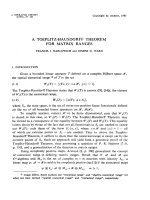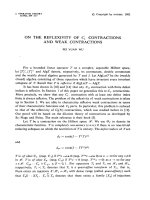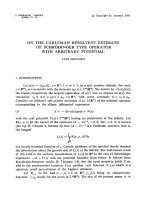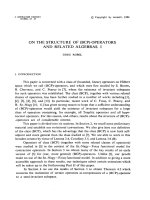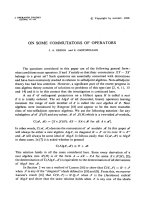Báo cáo toán học: "On some Ramsey and Tur´n-type numbers for paths a and cycles" doc
Bạn đang xem bản rút gọn của tài liệu. Xem và tải ngay bản đầy đủ của tài liệu tại đây (110.96 KB, 9 trang )
On some Ramsey and Tur´an-type numbers for paths
and cycles
Tomasz Dzido
Institute of Mathematics, University of Gda´nsk
Wita Stwosza 57, 80-952 Gda´nsk, Poland
Marek Kubale
Algorithms and System Modelling Department, Gda´nsk University of Technology
G. Narutowicza 11/12, 80–952 Gda´nsk, Poland
Konrad Piwakowski
Algorithms and System Modelling Department, Gda´nsk University of Technology
G. Narutowicza 11/12, 80–952 Gda´nsk, Poland
Submitted: Nov 15, 2005; Accepted: Jul 3, 2006; Published: Jul 11, 2006
Mathematics Subject Classifications: 05C55, 05C15, 05C38
Abstract
For given graphs G
1
,G
2
, , G
k
,wherek ≥ 2, the multicolor Ramsey number
R(G
1
,G
2
, , G
k
) is the smallest integer n such that if we arbitrarily color the edges
of the complete graph on n vertices with k colors, there is always a monochromatic
copy of G
i
colored with i,forsome1≤ i ≤ k.LetP
k
(resp. C
k
) be the path
(resp. cycle) on k vertices. In the paper we show that R(P
3
,C
k
,C
k
)=R(C
k
,C
k
)=
2k − 1foroddk. In addition, we provide the exact values for Ramsey numbers
R(P
4
,P
4
,C
k
)=k +2andR(P
3
,P
5
,C
k
)=k +1.
1 Introduction
In this paper all graphs considered are undirected, finite and contain neither loops nor
multiple edges. Let G be such a graph. The vertex set of G is denoted by V (G), the
edge set of G by E(G), and the number of edges in G by e(G). C
m
denotes the cycle
of length m and P
m
– the path on m vertices. For given graphs G
1
,G
2
, , G
k
,k ≥ 2,
the multicolor Ramsey number R(G
1
,G
2
, , G
k
) is the smallest integer n such that if we
arbitrarily color the edges of the complete graph of order n with k colors, then it always
contains a monochromatic copy of G
i
colored with i, for some 1 ≤ i ≤ k.Weonly
the electronic journal of combinatorics 13 (2006), #R55 1
consider 3-color Ramsey numbers R(G
1
,G
2
,G
3
) (in other words we color the edges of K
n
with colors red, blue and green). The Tur´an number T (n, G) is the maximum number
of edges in any n-vertex graph which does not contain a subgraph isomorphic to G.By
T
(n, G) we denote the maximum number of edges in any n-vertex non-bipartite graph
which does not contain a subgraph isomorphic to G. A non-bipartite graph on n vertices
is said to be extremal with respect to G if it does not contain a subgraph isomorphic
to G and has exactly T
(n, G)edges. ByT
∗
(n, G)wedenotethemaximumnumberof
edges in any n-vertex bipartite graph which does not contain a subgraph isomorphic to
G. For any v ∈ V (G), by r(v), b(v)andg(v) we denote the number of red, blue and
green edges incident to v, respectively. The degree of vertex v will be denoted by d(v)
and the minimum degree of a vertex of G by δ(G). The open neighbourhood of vertex v
is N(v)={u ∈ V (G)|{u, v}∈E(G)}. G
1
∪ G
2
denotes the graph which consists of two
disconnected subgraphs G
1
and G
2
. kG stands for the graph consisting of k disconnected
subgraphs G. We will use G
1
+ G
2
to denote the join of G
1
and G
2
, defined as G
1
∪ G
2
together with all edges between G
1
and G
2
.
The remainder of this paper is organized as follows. Section 2 contains some facts on
the numbers T
(n, G), where G is a cycle. We first establish the exact value of T
(n, C
k
),
where k ≤ n ≤ 2k − 2. Next, we continue in this fashion to obtain an upper bound for
T
(2k−1,C
k
). Section 3 contains our main result that R(P
3
,C
k
,C
k
)=R(C
k
,C
k
)=2k−1,
where C
k
is the odd cycle on k vertices. The last Section 4 presents two new formulas for
the following Ramsey numbers: R(P
4
,P
4
,C
k
)=k +2andR(P
3
,P
5
,C
k
)=k +1.
2ValuesofT
(n, C
k
)
First, we present some facts which are often used in the paper.
Definition 1 The circumference c(G) of a graph G is the length of its longest cycle.
Definition 2 The girth of a graph G is the length of its shortest cycle.
Definition 3 A graph is called weakly pancyclic if it contains cycles of every length
between the girth and the circumference.
Theorem 4 (Brandt, [3]) A non-bipartite graph G of order n and more than
(n−1)
2
4
+1
edges contains all cycles of length between 3 and the length of the longest cycle (thus such
a graph is weakly pancyclic of girth 3).
Theorem 5 (Brandt, [4]) Every non-bipartite graph G of order n with minimum degree
δ(G) ≥ (n +2)/3 is weakly pancyclic of girth 3 or 4.
The following notation and terminology comes from [6].
For positive integers a and b define r(a, b)as
r(a, b)=a − b
a
b
= a mod b.
the electronic journal of combinatorics 13 (2006), #R55 2
For integers n ≥ k ≥ 3, define w(n, k)as
w(n, k)=
1
2
(n − 1)k −
1
2
r(k − r − 1),
where r = r(n − 1,k− 1).
Woodall’s theorem [12] can then be written as follows.
Theorem 6 ([6]) Let G be a graph on n vertices and m edges with m ≥ n and c(G)=k.
Then
m ≤ w(n, k)
and this result is the best possible.
First, we state the following lemma.
Lemma 7 If n ≥ 2k − 3 and k ≥ 1, then T
∗
(kK
2
,n)=(k − 1)n − (k − 1)
2
.
Proof. The proof is by induction on k. It is clear that T
∗
(K
2
,n) = 0 for any integer n.
It is easy to see that K
1,r
for r ≥ 1andK
3
are the only connected graphs which do not
contain K
2
∪ K
2
.ThusweobtainT
∗
(2K
2
,n)=n − 1 for all n,sinceK
3
is not bipartite.
Let G be any nonempty bipartite graph of order n, which does not contain kK
2
.
Choose any edge vw. Define H to be the subgraph induced by V (G) −{v,w}. Obviously
H cannot contain (k−1)K
2
, so by the induction hypothesis e(H) ≤ (k−2)(n−2)−(k−2)
2
.
Since G is bipartite, so the number of edges with at least one vertex in {v, w} is not greater
than n−1. Thus we obtain e(G) ≤ (k −2)(n−2) −(k −2)
2
+(n−1) = (k −1)n−(k −1)
2
,
which implies T
∗
(kK
2
,n) ≤ (k − 1)n − (k − 1)
2
. The graph K
k−1,n−k+1
implies that
T
∗
(kK
2
,n) ≥ (k − 1)n − (k − 1)
2
=(k − 1)(n − k +1).
Lemma 8 Let G be a bipartite graph of order 2k − 2 with k
2
− 3k +4edges, where k is
odd and k ≥ 9. Then any two vertices, which belong to different sides of the bipartition,
are joined by a path of length k − 2.
Proof. Let {X, Y } be the bipartition of G and choose any two vertices x ∈ X, y ∈ Y .
Graph G can be seen as a complete bipartite graph without at most k − 3 edges. Define
X
=(X \{x}) ∩ N(y)andY
=(Y \{y}) ∩ N(x). The number of edges in G guarantees
that |X
|≥1, |Y
|≥1and|X
| + |Y
|≥2k − 4 − (k − 3) = k − 1. Thus the complete
bipartite graph with bipartition {X
,Y
} contains at least k − 2 edges, so at least one of
them, say vw,wherev ∈ X
and w ∈ Y
must belong to G as well. In this way we obtain
path xwvy, which is a path of length 3 joining x and y. Now we will show that any path
of length at least 3 but shorter than k − 2 which joins x and y can be extended by two
additional vertices to a longer path joining x and y, which by induction completes the
proof.
Assume that x and y are joined by a path P of length k − p,where4≤ p ≤ k − 3.
Define G
= G[V (G) \ V (P )]. We have e(G
)=e(G) − e(P ) −|{vw ∈ E(G):v ∈ P,w ∈
the electronic journal of combinatorics 13 (2006), #R55 3
G
}| ≥ k
2
− 3k +4− (k − p +1)
2
/4 − (k − p +1)(k + p − 3)/2. From Lemma 7 we
have T
∗
((p/2+1)K
2
,k + p − 3) = (p
2
+2kp − 6p)/4. One can easily verify that this
implies e(G
) ≥ T
∗
((p/2+1)K
2
,k + p − 3) and thus G
contains p/2 + 1 independent
edges. Assume that there is no path of order k − p + 2 joining x and y in graph G.In
this case any edge from G
can be connected to at most (k − p +1)/2 vertices from P or
in other words cannot be connected to at least (k − p +1)/2 vertices from P.Sowehave
e(G) ≤ e(K
k−1,k−1
) −|{vw ∈ E(G):v ∈ P, w ∈ G
}| ≤ (k − 1)
2
− (p/2+1)(k − p+1)/2=
k
2
− (10 + p)k/4+(p
2
+ p +2)/4 <k
2
− 3k +4 =e(G), a contradiction. Hence there must
beapathoforderk − p + 2 joining x and y in graph G.
Theorem 9 For odd integers k ≥ 5
T
(n, C
k
)=w(n, k − 1),
where k ≤ n ≤ 2k − 2.
Proof. The last part of the thesis of Theorem 6 implies that T
(n, C
k
) ≥ w(n, k − 1).
Let us suppose that there exists a non-bipartite C
k
-free graph G
on n vertices which
has more than w(n, k − 1) edges. Observe that w(n, k) is not a decreasing function of
k and of n, i.e. w(n, k
1
) ≥ w(n, k
2
)ifk
1
>k
2
and w(n
1
,k) ≥ w(n
2
,k)ifn
1
>n
2
.
Then, graph G
must contain a cycle of length greater than k. Now, we prove that
w(n, k − 1)+1 >
(n−1)
2
4
+ 1. The maximal possible value of n is 2k − 2. Then, the
left-hand side is equal to k
2
− 3k + 4 and the right-hand side is equal to k
2
− 3k +
13
4
,
so by Brandt’s theorem graph G
contains C
k
. For the case n =2k − 3 we obtain that
r(n − 1,k − 2) = 0 and w(n, k − 1) + 1 >
(n−1)
2
4
+1, and G
also contains a cycle of
length k. For the case n ≤ 2k − 4wehavethatr(n − 1,k − 2) = n − (k − 1). Then,
w(n, k −1)+ 1 =
1
2
n
2
+k
2
−kn−3k +
3
2
n+3 and the inequality w(n, k −1)+1 >
(n−1)
2
4
+1
implies the following inequality:
n
2
4
+ n(2 − k)+k
2
+
7
4
> 3k. The minimal value of the
left-hand side holds for n =2k − 4 and it is equal to 4k − 2.25, so for k ≥ 3graphG
contains a cycle of length k.
Theorem 10 For odd integers k ≥ 9
T
(2k − 1,C
k
) ≤
(2k − 2)
2
4
− 1=(k − 1)
2
− 1.
Proof. Let G be a non-bipartite graph of order 2k − 1. By Theorem 4 and by property
w(2k − 1,k− 1) = k
2
− 3k +5<
(2k−2)
2
4
+ 2 we obtain that if G has at least
(2k−2)
2
4
+2
edges, then it contains C
k
.
Assume that G has
(2k−2)
2
4
+1=k
2
− 2k + 2 edges. Suppose that there is a vertex
v ∈ V (G) such that d(v) ≤ k − 2. If G − v is a non-bipartite subgraph, we immediately
the electronic journal of combinatorics 13 (2006), #R55 4
obtain a contradiction with T
(2k − 2,C
k
)=k
2
− 3k +3, soG − v must be bipartite. It is
clear that vertex v must be joined to at least one vertex in each side of the bipartition of
G−v. Applying Lemma 8 we find a cycle C
k
in graph G,sowehavethatδ(G)=k −1. In
this case, the number of edges of graph G is at least
(2k−1)(k−1)
2
= k
2
−
3
2
k+
1
2
>k
2
−2k +2,
a contradiction. These observations lead us to the conclusion that a non-bipartite graph
G on 2k − 1 vertices and
(2k−2)
2
4
+ 1 edges must contain a cycle C
k
.
Consider the last case when G has (k − 1)
2
edges. Since w(2k − 1,k− 1) < (k − 1)
2
for k>4andw(k, n) is a non-decreasing function of k and n,graphG must contain a
cycle of length at least k. It follows that δ(G) ≥ k − 2. We obtain this property using the
same arguments as those in the previous case. Since k − 2 ≥ (2k +1)/3 for k ≥ 7, then
by Theorem 5 graph G is weakly pancyclic of girth 3 or 4, so it contains a cycle of length
k.
Finally, for the sake of completeness we recall a few Tur´an numbers for short paths.
In 1975 Faudree and Schelp proved
Theorem 11 ([9]) If G is a graph with |V (G)| = kt + r, 0 ≤ r<k, containing no
path on k +1 vertices, then |E(G)|≤t
k
2
+
r
2
with equality if and only if G is either
(tK
k
) ∪ K
r
or ((t − l − 1)K
k
) ∪ (K
(k−1)/2
+ K
(k+1)/2+ik+r
) for some l, 0 ≤ l<t, when k
is odd, t>0, and r =(k ± 1)/2.
It is easy to check that we obtain the following
Corollary 12 For all integers n ≥ 3
T (n, P
3
)=
n
2
T (n, P
4
)=
n if n ≡ 0mod3
n−1 otherwise.
T (n, P
5
)=
3n
2
if n ≡ 0mod4
3n
2
− 2 if n ≡ 2mod4
3n
2
−
3
2
otherwise
3 Ramsey numbers for odd cycles
In 1973 Bondy and Erd˝os proved that
Theorem 13 ([2]) For odd integers k ≥ 5
R(C
k
,C
k
)=2k − 1
the electronic journal of combinatorics 13 (2006), #R55 5
In 1983 Burr and Erd˝os gave the following Ramsey number.
Theorem 14 ([5])
R(P
3
,C
3
,C
3
)=11
In 2005 the first author determined two further numbers of this type.
Theorem 15 ([8])
R(P
3
,C
5
,C
5
)=9
R(P
3
,C
7
,C
7
)=13
Now, we prove our the main result of the paper.
Theorem 16 For odd integers k ≥ 9
R(P
3
,C
k
,C
k
)=R(C
k
,C
k
)=2k − 1
Proof. Let the complete graph G on 2k − 2 vertices be colored with two colors, say blue
and green, as follows: the vertex set V (G)ofG is the disjoint union of subsets G
1
and
G
2
,eachoforderk − 1 and completely colored blue. All edges between G
1
and G
2
are
colored green. This coloring contains neither monochromatic (blue or green) cycle C
k
nor
a monochromatic (red) path of length 2. We conclude that R(P
3
,C
k
,C
k
) ≥ 2k − 1.
Assume that the complete graph K
2k− 1
is 3-colored with colors red, blue and green. By
Corollary 12, in order to avoid a red P
3
, there must be at most k − 1 red edges. Suppose
that K
2k− 1
contains at most k − 1 red edges and contains neither a blue nor a green C
k
.
Since the number of blue and green edges is greater or equal to
2k− 1
2
−(k−1)=2(k−1)
2
,
at least one of the blue or green color classes (say blue) contains at least (k − 1)
2
edges.
If the blue color class is bipartite, then one of the partition sets has at least k vertices.
Since R(P
3
,C
k
)=k for k ≥ 5 [11], the graph induced by this partition has to contain a
red P
3
or a green C
k
, so blue edges enforce a non-bipartite subgraph of order 2k − 1with
at least (k − 1)
2
edges which by Theorem 10 contains a blue C
k
.
4 The Ramsey numbers R(P
l
,P
m
,C
k
)
This section makes some observations on 3-color Ramsey numbers for two short paths
and one cycle of arbitrary length.
In [1] we find two values of Ramsey numbers: R(P
4
,P
4
,C
3
)=9andR(P
4
,P
4
,C
4
)=7.
By using simple combinatorial properties (without the aid of computer calculations) we
proved: R(P
4
,P
4
,C
5
)=9andR(P
4
,P
4
,C
6
) = 8 (see [7] for details).
Theorem 17
R(P
4
,P
4
,C
7
)=9.
the electronic journal of combinatorics 13 (2006), #R55 6
Proof. The proof of R(P
4
,P
4
,C
7
) ≥ 9 is very simple, so it is left to the reader. Let the
vertices of K
9
be labeled 1, 2, ,9. Since R(P
4
,P
4
,C
6
) = 8, we can assume 1, 2, 3, 4, 5, 6
to be the vertices of green C
6
. If the subgraph induced by green edges of K
9
is bipartite,
then since R(P
4
,P
4
) = 5, we immediately obtain a red or a blue P
4
.SinceT (9,P
4
)=9,
the number of green edges is at least 18 >
(9−1)
2
4
+ 1, so the non-bipartite subgraph
induced by green edges of K
9
is weakly pancyclic. Since R(P
4
,P
4
,C
3
) = 9, this subgraph
contains green cycles of every length between 3 and the green circumference. Avoiding a
green cycle C
7
we know that the number of green edges from vertices 7, 8, 9 to the green
cycle is at most 3. We have to consider the two following cases.
1. There is a vertex v ∈{7, 8, 9} which has three green edges to the vertices of green
cycle C
6
. We can assume that the edges {1, 7}, {3, 7}, {5, 7} are green. In this case
the edges {2, 4}, {4, 6}, {2, 6} are red or blue. Without loss of generality we can
assume that {2, 4} and {4, 6} are red. This enforces {2, 7}, {6, 7} to be blue and
{2, 8}, {6, 8} to be green, and we obtain a green cycle of length 8 and then a green
C
7
.
2. There is a vertex v ∈{7, 8, 9} which has two green edges to the vertices of green
cycle C
6
. We have to consider two subcases.
(i) The edges {1, 7}, {3, 7} are green and {2, 7}, {4, 7}, {5, 7}, {6, 7} are red or
blue. This enforces { 2, 6} and {2, 4} to be red or blue. We obtain two situations.
In the first, if edge {2, 6} is red and {2, 4} blue, then we can assume that edge
{2, 7} is blue, then {5, 7} is red and we obtain a red or a blue P
4
with edge
{6, 7}. In the second, if edges {2, 6} and {2, 4} are red, then { 4, 7}, {6, 7} are
blue and {4, 8}, {6, 8}, {4, 9}, { 6, 9} are green. Edge {2, 6} cannot be green.
If edge {5, 8} is red, then we obtain a blue P
4
:2− 5 − 7 − 6andif{5, 8} is
blue, then we have a red P
4
:6− 2 − 5 − 7.
(ii) The edges {1, 7}, {4, 7} are green and {2, 7}, {3, 7}, {5, 7}, {6, 7} are red or
blue. Then vertex 8 and vertex 9 have green edges to at most one vertex from
{2, 3, 5, 6}, otherwise we have either the situation considered in (i) or a green
cycle of length 8. By simple considering red and blue edges from {7, 8, 9} to
{2, 3, 5, 6}, we obtain a red or a blue P
4
.
We obtain that there are at least 15 non-green edges from {7, 8, 9} to the vertices of
the green C
6
. We can assume that there are at least 8 blue edges among them and we
immediately have a blue P
4
.
Theorem 18 For all integers k ≥ 6
R(P
4
,P
4
,C
k
)=k +2.
the electronic journal of combinatorics 13 (2006), #R55 7
Proof. The critical coloring which gives us the lower bound k + 2 is easy to obtain,
so we only give a proof for the upper bound. This proof can be easily deduced from
Tur´an numbers and the theorems given above. By Theorem 9 and Corollary 12 we obtain
that T
(k +2,C
k
)=
1
2
k
2
−
3
2
k + 7 for k ≥ 5andT(k +2,P
4
) ≤ k +2. It is easy
to check that T
(k +2,C
k
) is greater than the maximal number of edges in a bipartite
graph on k + 2 vertices, thus T (k +2,C
k
)=T
(k +2,C
k
). Suppose that we have a
3-coloring of the complete graph K
k+2
. This graph has
1
2
k
2
+
3
2
k + 1 edges. Note that
T (k +2,C
k
)+2T (k +2,P
4
) ≤
1
2
k
2
+
1
2
k +11 <
1
2
k
2
+
3
2
k +1 for all k>10. If k ∈{8, 9, 10},
we obtain that T (k +2,C
k
)+2T (k +2,P
4
) ≤
k+2
2
with equality for k =8andk = 10,
so R(P
4
,P
4
,C
9
) = 11. By Theorem 11 we know the properties of the extremal graphs
with respect to P
4
and by Theorem 9 and [6] we can describe the extremal graphs with
respect to C
k
, so it is easy to check that the theorem holds for the remaining cases when
k ∈{8, 10}.
The following lemma will be useful in further considerations.
Lemma 19 Suppose that graph G has k+1 vertices and it contains a cycle C
k
and suppose
that we have a vertex v/∈ V (C
k
), which is joined by r edges to C
k
, where 2 ≤ r ≤ k.
Then one of the following two possibilities holds:
(i) G contains a cycle C
k+1
.
(ii) G
= G[V (C
k
)] contains at most
k(k−1)
2
−
r(r−1)
2
edges.
Proof. Let C = x
1
x
2
x
3
x
k
be a cycle C
k
and v/∈ V (C) be a vertex, which is joined by
d(v)=r edges to C,where2≤ r ≤ k.First,ifr ≥
k
2
, then we immediately have a
cycle C
k+1
and (i) follows. Assume that 2 ≤ r ≤
k
2
− 1. Let the vertices of C,whichare
joined by an edge to vertex v, be labeled p
i
1
,p
i
2
, , p
i
r
. Ifanytwoofthemareadjacent,
then we obtain the cycle C
k+1
and (i) follows. Otherwise, consider the following vertices:
p
i
1
+1
,p
i
2
+1
, , p
i
r
+1
. In order to avoid a cycle C
k+1
, these vertices must be mutually
nonadjacent and G
contains at most
k(k−1)
2
−
r(r−1)
2
edges.
Theorem 20 For all integers k ≥ 8
R(P
3
,P
5
,C
k
)=k +1.
Proof. A critical coloring which gives us the lower bound k + 1 is very simple, so all we
need is the upper bound. It is easy to see that simply using Tur´an numbers does not give
us the proof. Indeed, the sum T(k +1,P
3
)+T (k +1,P
5
)+T (k +1,C
n
) is far greater than
the maximal number of edges in the complete graph on k + 1 vertices. Suppose that we
have a 3-coloring of K
k+1
with colors red, blue and green which neither contains a red P
3
,
nor a blue P
5
, nor a green C
k
. K
k+1
has to contain a green cycle C
k−1
. Indeed, suppose
the electronic journal of combinatorics 13 (2006), #R55 8
that this is not the case. Since T (k +1,P
3
)+T (k +1,P
5
)+T (k +1,C
k−1
) <
k+1
2
for
k>11, we obtain either a red P
3
or a blue P
5
. For the case of k ∈{8, 9, 10, 11} we use
the properties of the extremal graphs with respect to P
3
and P
5
and we also obtain either
aredP
3
or a blue P
5
. Let the vertices of K
k+1
be labeled v
0
,v
1
, , v
k
. We can assume
the first k − 1 vertices to be the vertices of green C
k−1
. It is easy to see that b(v
k−1
)and
b(v
k
) are greater or equal to k −(k − 1)/2−1. Note that in order to avoid a blue P
5
we
obtain that the vertices v
k−1
and v
k
have no common vertex which belongs to V (C
k−1
)
and which is joined by a blue edge to them. If the vertex v
k−1
or v
k
is joined by at least
4 green edges to the vertices of C
k−1
, then by Lemma 19 and R(P
3
,P
5
)=5wehavea
blue P
5
.Ifv
k−1
and v
k
are joined by at most 3 green edges to the vertices of C
k−1
,then
by Lemma 19 and R(P
3
,P
4
) = 4 we obtain a blue P
4
.Ifk ≥ 9 then we also have a blue
P
5
.Inthecasek = 8 by simple considering possible colorings of the edges of v
k−1
and v
k
we obtain either a red P
3
, or a blue P
5
, or else a green C
k
.
References
[1] Arste J., Klamroth K., Mengersen I.: Three color Ramsey numbers for small graphs,
Util. Math. 49 (1996) 85–96.
[2] Bondy J.A., Erd˝os P.: Ramsey numbers for cycles in graphs, J. Combin. Theory Ser.
B 14 (1973) 46–54.
[3] Brandt S.: A sufficient condition for all short cycles, Disc. Appl. Math. 79 (1997)
63–66
[4] Brandt S.: Sufficient conditions for graphs to contain all subgraphs of a given type,
Ph.D. Thesis, Freie Universit¨at Berlin, 1994.
[5] Burr A., Erd˝os P.: Generalizations of a Ramsey-theoretic result of Chvatal, J. Graph
Theory 7 (1983) 39–51.
[6] Caccetta L., Vijayan K.: Maximal cycles in graphs, Disc. Math. 98 (1991) 1–7.
[7] Dzido T.: Computer experience from calculating some 3-color Ramsey numbers,
Technical Report of Gda´nsk University of Technology, ETI Faculty 18/03 (2003).
[8] Dzido T.: Multicolor Ramsey numbers for paths and cycles, Discuss. Math. Graph
Theory 25 (2005) 57–65.
[9] Faudree R.J., Schelp R.H.: Path Ramsey numbers in multicolorings, J. Combin.
Theory Ser. B 19 (1975) 150–160.
[10] Greenwood R.E., Gleason A.M.: Combinatorial relations and chromatic graphs,
Canad. J. Math. 7 (1955) 1–7.
[11] Radziszowski S.P.: Small Ramsey numbers, Electronic Journal of Combinatorics,
Dynamic Survey 1, revision #10, July 2004, .
[12] Woodall D.R.: Maximal circuits of graphs I, Acta Math. Acad. Sci. Hungar. 28 (1976)
77–80.
the electronic journal of combinatorics 13 (2006), #R55 9


